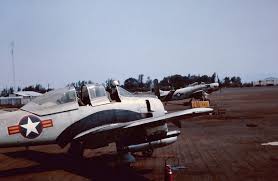–
In an age of intercontinental missiles and space shots, the air war in Vietnam is a throwback to a strange and ancient era. There is no enemy air resistance. But at the low levels at which Vietnamese and US aircrews operate, even small arms fire can be deadly, and sabotage by Viet Cong infiltrators is an ever-present danger.
Seeking out the elusive enemy, pinpointing targets hidden under dense jungle canopy, flying fighter escort for helicopters, or clearing the way for airborne assaults calls for aircraft with a variety of weapons and the ability to fly fast or slow. Here the World War II B-26 Invader, the A-1H Skyraider (formerly AD-6), and the T-28B trainer have proved well adapted to the job. The versatile C-123 (see front cover) drops paratroops, hauls food and weapons to remote fortified outposts, and evacuates the sick and wounded.
South Vietnam’s Flying Tigers, trained in US pilot schools and assisted by USAF advisers, are becoming expert in these unusual techniques. In turn, US Air Commandos are gaining vital combat experience in their mission of training free-world forces to prevent or win guerrilla war.
« « «
South Vietnam’s 516th Flying Tiger Squadron celebrated its first anniversary early in March with an air show at its Nha Trang Air Base. The tiger bears a special meaning for Vietnamese who admire and fear its deadly power, its speed, and cunning skill. Thousands of Vietnamese came to watch the show.
Formal ceremonies included a salute to Col. Huyen Huu Hien, Commander of the South Vietnamese Air Force; to Brig. Gen. Robert Rowland, Chief of the USAF Military Assistance Advisory Group in Vietnam; and to Capt. Pham Long Suu, 516th Squadron Commander.
The squadron had plenty to celebrate. Organized a year ago, it flew twelve combat missions in its first month, stepping up operations rapidly as it gained more pilots and planes until it now flies more than 400 a month.
Captain Suu, who began flying in 1953, holds Pilot License No. 1 in South Vietnam. In more than 200 combat missions, his plane has been hit by enemy fire more often than all other planes in his squadron combined. The Viet Cong have come to know and fear his plane and are anxious to bring it down.
But Captain Suu shrugs off the dangers. “My pilots,” he says, “are all tigers.”
« « «
Twenty Air Force men have been killed in Vietnam—ten in combat and ten in other accidents. Three USAF fatalities occurred in early February, both in B-26s. On February 3, Capts. J. F. Shaughnessy and J. P. Bartley crashed on a combat strike. Three days later a B-26 piloted by Maj. James R. O’Neill lost power in both engines. He kept the plane aloft long enough for his navigator and observer to bail out before he died.
At services for the three, Brig. Gen. R. H. Anthis, 2d Air Division Commander, said: “Our tasks and our sacrifices are no less important to the entire free world than to the people of South Vietnam.”
« « «
Air transport is vital to the South Vietnamese campaign against Communist invaders. Moving personnel and supplies by surface means—roads and canals—is slow and highly susceptible to ambush. The strategy calls for establishment of fortified hamlets to safeguard natives, food, and supplies from guerrilla depredations, and to serve as military bases from which to clear the Viet Cong from the surrounding countryside and set up more fortified villages.
C-123s of PACAF’s 2d Air Division are the lifeline connecting these hamlets. When not engaged in paratroop operations, the aircraft haul food and supplies, ferry civilians in and out, carry military personnel and weapons, and perform aeromedical missions.
This, then, is the air war in Vietnam—dangerous, dirty, but never dull. US airmen there are once again demonstrating USAF capability to operate in any environment from the jungle to space in defending the cause of freedom.
CAPTIONS THAT MAY NOT BE READABLE IN PDF
[Page 72, top] Heavily armed B-26s in Vietnam carry more armament under wings than B-17s carried internally in WW II, plus fourteen .50-caliber guns. Weapon mix includes 2.75- inch rocket pods, fragmentation and general purpose bombs, and flares. They also carry reconnaissance camera.
[Page 72, bottom right] USAF Air Commando crewmen load 2.75-inch rockets in wing pod of a B-26 bomber. Commandos, based at Hurlburt Field, Fla., rotate to Vietnam for periods of four to six months.
[Page 73, first middle left] Capts. Donald J. Maxwell and Waldo H. Miller receive DFCs from Brig. Gen. Rollen H. Anthis, 2d Air Division Commander. Seven others, since reassigned, also won award.
[Page 73, second middle left] Lt. W. A. Blackburn, who has logged 650 combat support hours, was one of twenty-seven USAF pilots awarded Vietnamese AF wings by Col. Huyen Huu Hien, VNAF chief.
